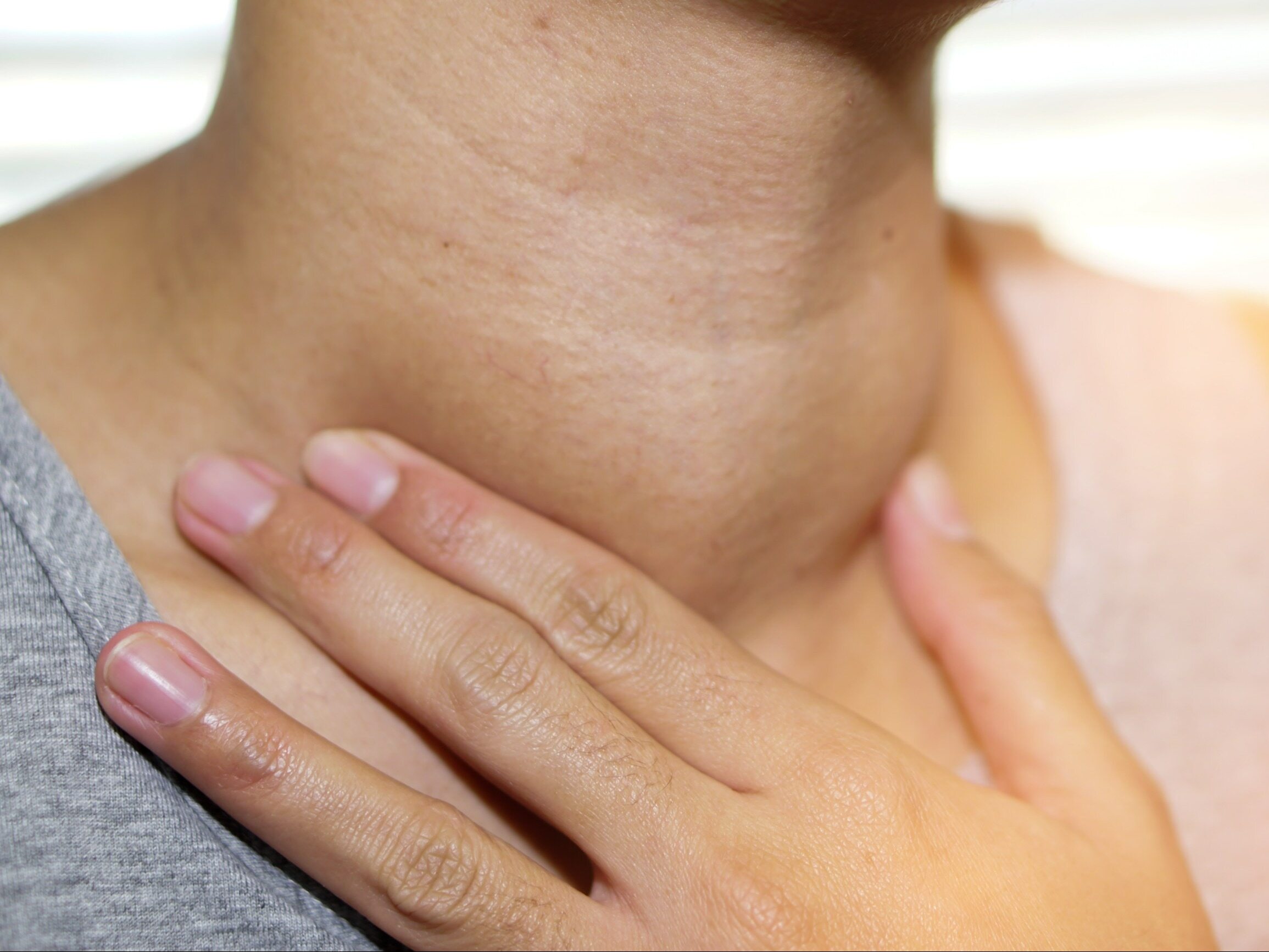Thyroid nodules should be monitored. Learn about their causes, symptoms and treatment

Thyroid nodules are focal lesions within the thyroid gland that differ from the surrounding healthy tissue. Depending on the disease that causes thyroid nodules, we are dealing with single or multiple lesions located in one or both lobes of the thyroid gland. See where the thyroid nodules come from. We explain the most common symptoms of thyroid nodules and the treatment of thyroid nodules.
- Thyroid nodules – what is worth knowing?
- Thyroid nodules – causes
- Thyroid nodules – symptoms
- How are thyroid nodules diagnosed?
- Thyroid nodules – treatment
Thyroid nodules are abnormal formations that may arise within the parenchyma of this endocrine gland. Typically, non-cancerous thyroid nodules arise from thyroid follicular cells. Large and small but numerous nodules on the thyroid gland may cause symptoms of hyperthyroidism or hypothyroidism and may press on the surrounding structures of the neck, causing various ailments. It happens that nodules formed in the thyroid gland are composed of cancer cells, which may be malignant. Thyroid testing is an element of health prevention, including: adult women. It is worth regularly performing a physical examination, thyroid ultrasound and thyroid hormone levels, because thyroid gland diseases often develop asymptomatically. Not all thyroid changes require immediate treatment. In some cases, regular monitoring of detected nodules is enough to check whether they have not enlarged.
Thyroid nodules – what is worth knowing?
Thyroid tumors are often diagnosed in adults – it is estimated that they may occur in up to 10-30%. population. Changes in the thyroid gland are more common in women, which may be related to, among others, with changes in hormone levels. In about 5 percent In patients, thyroid nodules can be felt during palpation by a doctor. It sometimes happens that the patient himself senses the presence of changes in the thyroid gland because they cause discomfort, e.g. when swallowing. Most thyroid nodules are benign and do not cause any symptoms or hormonal disorders. However, changes in the thyroid gland should not be underestimated, as they may begin to disturb the functioning of this endocrine gland.
It’s worth knowing that the thyroid gland secretes hormones that significantly affect the functioning of the bodies of women and men. Thyroid disorders may increase the risk of developing serious diseases, including: heart and circulatory system diseases.
Solid thyroid nodules (made of thyroid parenchyma) as well as fluid-filled cysts may develop within the thyroid gland. Depending on the type and origin of the lesion, not only a single thyroid nodule may form, but also nodular thyroid goiter (enlargement of the thyroid gland due to numerous nodules).
Thyroid nodules – causes
There is no clear cause for the formation of nodules on the thyroid gland. It is believed that their development is influenced by genetic factors, autoimmune thyroid diseases, environmental factors and hormonal factors. Some of the possible causes associated with the development of thyroid nodules include:
- iodine deficiency – it is necessary for the production of thyroid hormones. Its deficiency is one of the most common causes of thyroid enlargement and the formation of thyroid nodules;
- Hashimoto’s disease – is an autoimmune thyroid disease in which the body produces antibodies that attack its own thyroid tissue. The course of this autoimmune disease causes inflammation of the thyroid gland and may be associated with hypothyroidism and the formation of thyroid nodules;
- hyperthyroidism – causes the thyroid gland to produce excessive amounts of hormones. This may be caused by a hormone-producing nodule (called a hot nodule), Graves’ disease (an autoimmune disease) and treatment with radioactive iodine;
-
Thyroid cancer – a malignant tumor that is a rare cause of thyroid nodules. Malignant nodules (e.g. papillary carcinoma, medullary carcinoma, anaplastic carcinoma) constitute approximately 1–3% of all malignancies.
Thyroid nodules – symptoms
Most thyroid nodules cause no symptoms and are discovered incidentally during a physical examination or imaging test (thyroid ultrasound). Symptoms of thyroid nodules are related to the location, size and nature of the lesion. These include:
-
Nodular thyroid goiter – an enlargement of the thyroid gland visible at the base of the neck. Nodular goiter may be caused by one large or many small nodules;
-
swallowing and breathing disorders – discomfort while breathing and swallowing occurs when a lump presses on the trachea or esophagus and is often described as a feeling of pressure or a lump in the throat;
-
hoarseness or voice change – may be caused by damage to the recurrent laryngeal nerve, which runs near the thyroid gland and innervates the vocal cords;
-
Symptoms of hyperthyroidism – may occur when the nodule produces excessive amounts of thyroid hormones. Symptoms of hyperthyroidism include: feeling restless, anxiety, palpitations, excessive sweating, weight loss, hand tremors, heat intolerance, diarrhea, muscle weakness, bulging eyes;
-
Symptoms of hypothyroidism – may occur when a nodule inhibits the production of thyroid hormones or when an autoimmune disease destroys thyroid tissue. Symptoms of hypothyroidism include: fatigue, weight gain, cold intolerance, constipation, dry skin, hair loss, swelling, depression.
Alarm symptoms that should prompt immediate consultation with a doctor include: enlargement of the neck circumference, sudden weight loss, enlarged lymph nodes, neck discomfort (e.g. problems with swallowing).
How are thyroid nodules diagnosed?
Diagnosis of thyroid nodules includes tests that include:
- palpation of the thyroid gland – a basic physical examination that allows you to assess the size, shape and consistency of the thyroid gland and feel for any nodules;
- thyroid ultrasound examination – thyroid ultrasound is a non-invasive and painless imaging test that allows you to precisely see the structure and dimensions of the thyroid gland and assess the number and size of nodules;
- thyroid scintigraphy – a test involving intravenous or oral administration of an isotope of iodine and observation of its distribution within the thyroid gland using a gamma camera. Scintigraphy allows us to determine whether the nodules are hot (absorb more isotope than the surroundings), cold (absorb less isotope than the surroundings) or neutral (absorb the same amount of isotope as the surroundings);
- fine needle biopsy – a test consisting of collecting tumor cells using a thin needle under ultrasound guidance and performing a histopathological examination;
- Laboratory tests – tests from the patient’s blood, consisting in determining the concentration of thyroid hormones (TSH, FT4, FT3) and antithyroid antibodies.
Thyroid nodules – treatment
Treatment for thyroid nodules depends on their size, number and nature. Not every lump requires treatment. In some cases, observation is enough. The observation includes, among others: thyroid ultrasound examination, which should be performed every 6–12 months. Treatment may be necessary if the lump:
-
it is large (> 3 cm) and presses on adjacent structures,
-
is hot and causes symptoms of hyperthyroidism,
-
is part of a nodular goiter or a significantly enlarged thyroid gland,
-
the malignant nature of the change was confirmed.
Depending on the individual needs of the patient, the treatment of thyroid nodules includes pharmacological treatment, radioactive iodine treatment, ablative treatment and surgical treatment.
Pharmacological treatment of thyroid nodules involves the administration of iodine or L-thyroxine preparations, which aim to reduce the size of the nodules and prevent their growth. Iodine preparations are mainly used in cases of deficiency of this element in the body, which is one of the causes of nodules. L-thyroxine is a thyroid hormone that inhibits the secretion of thyrotropin (TSH).
Radioactive iodine treatment for thyroid nodules involves the administration of an isotope of iodine (I-131), which accumulates in the thyroid tissue and emits beta radiation, destroying the gland cells. Radioactive iodine treatment is effective in the case of hyperthyroidism caused by toxic nodules (secreting excess hormones), as well as in the case of thyroid cancer after surgery to remove the gland.
Ablative treatment of thyroid nodules involves focal destruction of the nodule tissue using various sources of heat or cold. This is a method used to treat single or several benign nodules with a diameter not exceeding 4 cm, if the result of fine-needle biopsy confirmed the benign nature of the lesion.
Surgical treatment for thyroid nodules involves removing all or part of the thyroid gland. This is a method used, among others, in case of suspicion or confirmation of malignancy of the nodules.
Sources:
-
Szwajkosz K., Wawryniuk A., Sawicka K., Łuczyk R., Tomaszewski A., Hypothyroidism as a result of chronic autoimmune inflammation of the thyroid gland, Journal of Education, Health and Sport, 7(5), pp. 41-54, 2017
-
Stanisław Konturek, Human Physiology Volume 5: Digestive system and internal secretion, Konturek’s Physiology, Jagiellonian University Publishing House, Kraków, 2023
-
Urszula Ambroziak, Thyroid diseases, Diagnosis and treatment, PZWL Wydawnictwo Lekarskie, Warszawa, 2022






